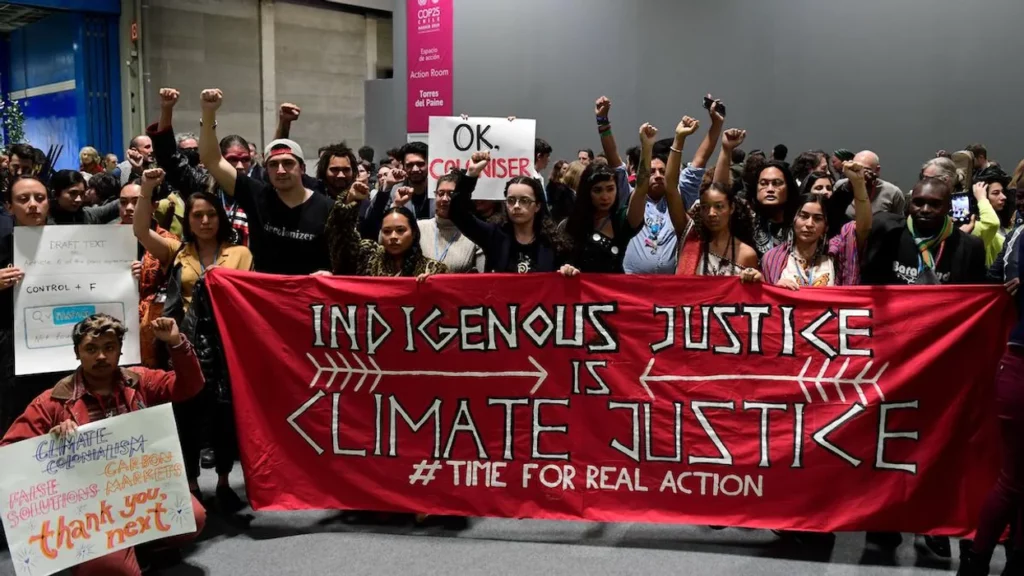Indigenous Groups Officially Excluded from COP26 Continue Calling for Action
ENVIRONMENT, 1 Nov 2021
Climate Nexus | EcoWatch - TRANSCEND Media Service

Demonstrators from indigenous communities take part in a protest during the UN Climate Change Conference COP25 in Madrid, Spain on Dec. 13, 2019.
CRISTINA QUICLER / AFP via Getty Images
27 Oct 2021 – Indigenous groups from around the world are preparing to travel to Glasgow for COP26 to call for climate action and demand a greater say in negotiations, the Arizona Republic reports.
However, despite being among the least culpable and most harmed by the climate crisis, they will not be fully credentialed while they seek to influence the important discussions already dogged by problems of inequitable access.
Since being elected as a tribal leader 15 years ago, Fawn Sharp, now the vice president of the Quinault Indian Nation in what is now Washington state, has seen the impacts of climate change, including rising sea levels, and shrinking glaciers and ocean acidification which are decimating salmon numbers — a crisis for tribes across the continent.
Andrea Carmen, a member of the Pascua Yaqui Tribe, the former co-chair of the UN’s Local Communities and Indigenous Peoples Platform Facilitative Working Group, and executive director of the International Indian Treaty Council has been fighting for a seat at the international table since COP15 in Copenhagen in 2009. She, along with other Indigenous rights activists, were able to get two references to Indigenous rights in the final draft of the Paris Agreement despite no Indigenous people being in the room where it happened.
“We called for our rights and knowledge to be respected, not just because of the impacts we were experiencing,” Carmen told the Republic, “but also we are convinced that our knowledge, our ancestral knowledge and practices had a lot to contribute to these discussions.”
Native activists have demanded the Biden Administration take stronger action to protect their land and water resources from fossil fuel extraction and pipelines, including the Enbridge Line 3 tar sands oil pipeline.
Tags: Activism, COP26, Climate Change, Environment, Global warming, Indigenous, Indigenous Culture, Paris Climate Agreement
DISCLAIMER: The statements, views and opinions expressed in pieces republished here are solely those of the authors and do not necessarily represent those of TMS. In accordance with title 17 U.S.C. section 107, this material is distributed without profit to those who have expressed a prior interest in receiving the included information for research and educational purposes. TMS has no affiliation whatsoever with the originator of this article nor is TMS endorsed or sponsored by the originator. “GO TO ORIGINAL” links are provided as a convenience to our readers and allow for verification of authenticity. However, as originating pages are often updated by their originating host sites, the versions posted may not match the versions our readers view when clicking the “GO TO ORIGINAL” links. This site contains copyrighted material the use of which has not always been specifically authorized by the copyright owner. We are making such material available in our efforts to advance understanding of environmental, political, human rights, economic, democracy, scientific, and social justice issues, etc. We believe this constitutes a ‘fair use’ of any such copyrighted material as provided for in section 107 of the US Copyright Law. In accordance with Title 17 U.S.C. Section 107, the material on this site is distributed without profit to those who have expressed a prior interest in receiving the included information for research and educational purposes. For more information go to: http://www.law.cornell.edu/uscode/17/107.shtml. If you wish to use copyrighted material from this site for purposes of your own that go beyond ‘fair use’, you must obtain permission from the copyright owner.